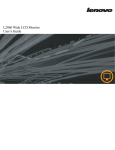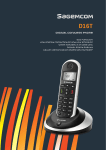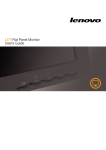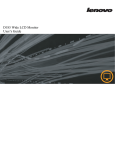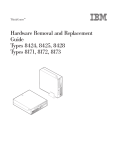Download Lenovo D186 User's Manual
Transcript
D186 Wide Flat Panel Monitor User’s Guide Contents Safety information . . . . . . . . . . . . . . . . . . . . . . . . . . . . . . . . . . . . . . . . . . . . . . . . . . . . . . . . . . . . . iii Chapter1. Getting started . . . . . . . . . . . . . . . . . . . . . . . . . . . . . . . . . . . . . . . . . . . . . . . . . . . . . . 1-1 Shipping contents . . . . . . . . . . . . . . . . . . . . . . . . . . . . . . . . . . . . . . . . . . . . . . . . . . . . . . . . . . . . . . . . . . . . . . . . . . . . . . . . . . . . . . . .1-1 Attaching the base and handling your monitor . . . . . . . . . . . . . . . . . . . . . . . . . . . . . . . . . . . . . . . . . . . . . . . . . . . . . . . . . . . . . .1-1 Product overview . . . . . . . . . . . . . . . . . . . . . . . . . . . . . . . . . . . . . . . . . . . . . . . . . . . . . . . . . . . . . . . . . . . . . . . . . . . . . . . . . . . . .1-2 Types of adjustments . . . . . . . . . . . . . . . . . . . . . . . . . . . . . . . . . . . . . . . . . . . . . . . . . . . . . . . . . . . . . . . . . . . . . . . . . . . . . . . . . .1-2 User controls . . . . . . . . . . . . . . . . . . . . . . . . . . . . . . . . . . . . . . . . . . . . . . . . . . . . . . . . . . . . . . . . . . . . . . . . . . . . . . . . . . . . . . . . .1-2 Cable lock slot . . . . . . . . . . . . . . . . . . . . . . . . . . . . . . . . . . . . . . . . . . . . . . . . . . . . . . . . . . . . . . . . . . . . . . . . . . . . . . . . . . . . . . . .1-3 Setting up your monitor . . . . . . . . . . . . . . . . . . . . . . . . . . . . . . . . . . . . . . . . . . . . . . . . . . . . . . . . . . . . . . . . . . . . . . . . . . . . . . . . . .1-3 Connecting and turning on your monitor . . . . . . . . . . . . . . . . . . . . . . . . . . . . . . . . . . . . . . . . . . . . . . . . . . . . . . . . . . . . . . . . .1-3 Chapter 2. Adjusting and using your monitor . . . . . . . . . . . . . . . . . . . . . . . . . . . . . . . . . . . . . 2-1 Comfort and accessibility . . . . . . . . . . . . . . . . . . . . . . . . . . . . . . . . . . . . . . . . . . . . . . . . . . . . . . . . . . . . . . . . . . . . . . . . . . . . . . . . .2-1 Arranging your work area . . . . . . . . . . . . . . . . . . . . . . . . . . . . . . . . . . . . . . . . . . . . . . . . . . . . . . . . . . . . . . . . . . . . . . . . . . . . . .2-1 Positioning and viewing your monitor . . . . . . . . . . . . . . . . . . . . . . . . . . . . . . . . . . . . . . . . . . . . . . . . . . . . . . . . . . . . . . . . .2-1 Quick tips for healthy work habits . . . . . . . . . . . . . . . . . . . . . . . . . . . . . . . . . . . . . . . . . . . . . . . . . . . . . . . . . . . . . . . . . . . . . . .2-2 Adjusting your monitor image . . . . . . . . . . . . . . . . . . . . . . . . . . . . . . . . . . . . . . . . . . . . . . . . . . . . . . . . . . . . . . . . . . . . . . . . . . . . .2-3 Using the direct access controls . . . . . . . . . . . . . . . . . . . . . . . . . . . . . . . . . . . . . . . . . . . . . . . . . . . . . . . . . . . . . . . . . . . . . . . . .2-3 Using the On-Screen Display (OSD) controls . . . . . . . . . . . . . . . . . . . . . . . . . . . . . . . . . . . . . . . . . . . . . . . . . . . . . . . . . . . . . .2-3 Selecting a supported display mode . . . . . . . . . . . . . . . . . . . . . . . . . . . . . . . . . . . . . . . . . . . . . . . . . . . . . . . . . . . . . . . . . . . . . . . .2-6 Understanding power management . . . . . . . . . . . . . . . . . . . . . . . . . . . . . . . . . . . . . . . . . . . . . . . . . . . . . . . . . . . . . . . . . . . . . . . .2-7 Caring for your monitor . . . . . . . . . . . . . . . . . . . . . . . . . . . . . . . . . . . . . . . . . . . . . . . . . . . . . . . . . . . . . . . . . . . . . . . . . . . . . . . . . .2-8 Detaching the monitor stand . . . . . . . . . . . . . . . . . . . . . . . . . . . . . . . . . . . . . . . . . . . . . . . . . . . . . . . . . . . . . . . . . . . . . . . . . . . . . .2-8 Chapter 3. Reference information . . . . . . . . . . . . . . . . . . . . . . . . . . . . . . . . . . . . . . . . . . . . . . . 3-1 Monitor specifications . . . . . . . . . . . . . . . . . . . . . . . . . . . . . . . . . . . . . . . . . . . . . . . . . . . . . . . . . . . . . . . . . . . . . . . . . . . . . . . . . . . .3-1 Troubleshooting. . . . . . . . . . . . . . . . . . . . . . . . . . . . . . . . . . . . . . . . . . . . . . . . . . . . . . . . . . . . . . . . . . . . . . . . . . . . . . . . . . . . . . . . . .3-3 Manual image setup . . . . . . . . . . . . . . . . . . . . . . . . . . . . . . . . . . . . . . . . . . . . . . . . . . . . . . . . . . . . . . . . . . . . . . . . . . . . . . . . . . .3-4 Manually installing the monitor driver . . . . . . . . . . . . . . . . . . . . . . . . . . . . . . . . . . . . . . . . . . . . . . . . . . . . . . . . . . . . . . . . . . .3-5 Installing the device driver in Windows Vista . . . . . . . . . . . . . . . . . . . . . . . . . . . . . . . . . . . . . . . . . . . . . . . . . . . . . . . . . . . . . .3-5 Installing the monitor driver in Windows XP . . . . . . . . . . . . . . . . . . . . . . . . . . . . . . . . . . . . . . . . . . . . . . . . . . . . . . . . . . . 3-6 Service information . . . . . . . . . . . . . . . . . . . . . . . . . . . . . . . . . . . . . . . . . . . . . . . . . . . . . . . . . . . . . . . . . . . . . . . . . . . . . . . . . . 3-7 Product numbers . . . . . . . . . . . . . . . . . . . . . . . . . . . . . . . . . . . . . . . . . . . . . . . . . . . . . . . . . . . . . . . . . . . . . . . . . . . . . . . . . . 3-7 Customer responsibilities . . . . . . . . . . . . . . . . . . . . . . . . . . . . . . . . . . . . . . . . . . . . . . . . . . . . . . . . . . . . . . . . . . . . . . . . . . . . 3-7 Service parts . . . .. . . . . . . . . . . . . . . . . . . . . . . . . . . . . . . . . . . . . . . . . . . . . . . . . . . . . . . . . . . . . . . . . . . . . . . . . . . . . . . . . 3-8 Appendix A. Service and Support . . . . . . . . . . . . . . . . . . . . . . . . . . . . . . . . . . . . . . . . . . . . . . A-1 Registering your option . . . . . . . . . . . . . . . . . . . . . . . . . . . . . . . . . . . . . . . . . . . . . . . . . . . . . . . . . . . . . . . . . . . . . . . . . . . . . . . . . .A-1 Online technical support . . . . . . . . . . . . . . . . . . . . . . . . . . . . . . . . . . . . . . . . . . . . . . . . . . . . . . . . . . . . . . . . . . . . . . . . . . . . . . . . . . . A-1 Telephone technical support . . . . . . . . . . . . . . . . . . . . . . . . . . . . . . . . . . . . . . . . . . . . . . . . . . . . . . . . . . . . . . . . . . . . . . . . . . . . . . .A-1 Appendix B. Notices . . . . . . . . . . . . . . . . . . . . . . . . . . . . . . . . . . . . . . . . . . . . . . . . . . . . . . . . . B-1 Trademarks . . . . . . . . . . . . . . . . . . . . . . . . . . . . . . . . . . . . . . . . . . . . . . . . . . . . . . . . . . . . . . . . . . . . . . . . . . . . . . . . . . . . . . . . . . . . . B-2 © Copyright Lenovo 2009. © ii Safety information Before installing this product, read the Safety Information. Antes de instalar este produto, leia as Informações de Segurança. Pred instalací tohoto produktu si prectete prírucku bezpecnostních instrukcí. Læs sikkerhedsforskrifterne, før du installerer dette produkt. Ennen kuin asennat tämän tuotteen, lue turvaohjeet kohdasta Safety Information. Avant d’installer ce produit, lisez les consignes de sécurité. Vor der Installation dieses Produkts die Sicherheitshinweise lesen. Prima di installare questo prodotto, leggere le Informazioni sulla Sicurezza. Lees voordat u dit product installeert eerst de veiligheidsvoorschriften. Les sikkerhetsinformasjonen (Safety Information) før du installerer dette produktet. Antes de instalar este produto, leia as Informações sobre Segurança. Antes de instalar este producto lea la información de seguridad. Läs säkerhetsinformationen innan du installerar den här produkten. iii D186 Wide Flat Panel Monitor User’s Guide Product overview This section will provide information on adjusting monitor positions, setting user controls, and using the cable lock slot. Types of adjustments Please see the illustration below for an example of the tilt range. User controls Your monitor has controls on the front which are used to adjust the display. For information on how to use these controls, please see “Adjusting your monitor image” on page 2-3. 1-2 D186 Wide Flat Panel Monitor User’s Guide 3. Plug the monitor power cord and the computer cord into grounded electrical outlets. 4. 1-4 Power on the monitor and the computer. D186 Wide Flat Panel Monitor User’s Guide 5. 6. To install the monitor driver, insert the Reference and Driver CD, click Install driver, and follow the on-screen instructions. To optimize your monitor image, press the Automatic Image Setup key. Automatic image setup requires that the monitor is warmed up for at least 15 minutes. This is not required for normal operation. Note: If automatic image setup does not establish the image that you prefer, perform manual image setup. See “Manual image setup” on page 3-4 . Chapter 1. 1-5 Chapter 2. Adjusting and using your monitor This section will give you information on adjusting and using your monitor. Comfort and accessibility Good ergonomic practice is important to get the most from your personal computer and to avoid discomfort. Arrange your workplace and the equipment you use to suit your individual needs and the kind of work that you perform. In addition, use healthy work habits to maximize your performance and comfort while using your computer. For more detailed information on any of these topics, visit the Healthy Computing Web site at: http://www.lenovo.com/healthycomputing/. Arranging your work area Use a work surface of appropriate height and available working area to allow you to work in comfort. Organize your work area to match the way you use materials and equipment. Keep your work area clean and clear for the materials that you typically use and place the items that you use most frequently, such as the computer mouse or telephone, within the easiest reach. Equipment layout and setup play a large role in your working posture. The following topics describe how to optimize equipment setup to achieve and maintain good working posture. Positioning and viewing your monitor Position and adjust your computer monitor for comfortable viewing by considering the following items: • Viewing distance: Optimal viewing distances for monitors range from approximately 510mm to 760mm (20 in to 30 in) and can vary depending on ambient light and time of day. You can achieve different viewing distances by repositioning your monitor or by modifying your posture or chair position. Use a viewing distance that is most comfortable for you. • Monitor height: Position the monitor so your head and neck are in a comfortable and neutral (vertical, or upright) position. If your monitor does not have height adjustments, you might have to place books or other sturdy objects under the base of the monitor to achieve the desired height. A general guideline is to position the monitor such that the top of the screen is at or slightly below your eye-height when you are comfortably seated. However, be sure to optimize your monitor height so the line of site between your eyes and the center the monitor suits your preferences for visual distance and comfortable viewing when your eye muscles are in a relaxed state. • Tilt: Adjust the tilt of your monitor to optimize the appearance of the screen content and to accommodate your preferred head and neck posture. • General location: Position your monitor to avoid glare or reflections on the screen from overhead lighting or nearby windows. The following are some other tips for comfortable viewing of your monitor: • © Copyright Lenovo 2009. © Use adequate lighting for the type of work you are performing. 2-1 • Use the monitor brightness, contrast, and image adjustment controls, if equipped, to optimize the image on your screen to meet your visual preferences. • Keep your monitor screen clean so you can focus on the screen’s contents. Any concentrated and sustained visual activity can be tiring for your eyes. Be sure to periodically look away from your monitor screen and focus on a far object to allow your eye muscles to relax. If you have questions on eye fatigue or visual discomfort, consult a vision care specialist for advice. Quick tips for healthy work habits The following information is a summary of some important factors to consider to help you remain comfortable and productive while you use your computer. 2-2 • Good posture starts with equipment setup: The layout of your work area and the setup of your computer equipment have a large effect on your posture while using your computer. Be sure to optimize the position and orientation of your equipment by following the tips outlined in “Arranging your work area” on page 2-1 so you can maintain a comfortable and productive posture. Also, be sure to use the adjustment capabilities of your computer components and office furniture to best suit your preferences now and as your preferences change over time. • Minor changes in posture can help avoid discomfort: The longer you sit and work with your computer, the more important it is to observe your working posture. Avoid assuming any one posture for an extended period of time. Periodically make minor modifications in your posture to help deter any discomforts that might arise. Make use of any adjustments that your office furniture or equipment provide to accommodate changes in posture • Short, periodic breaks help ensure healthy computing: Because computing is primarily a static activity, it is particularly important to take short breaks from your work. Periodically, stand up from your work area, stretch, walk for a drink of water, or otherwise take a short break from using your computer. A short break from work gives your body a welcome change in posture and helps to ensure you remain comfortable and productive while you do work. D186 Wide Flat Panel Monitor User’s Guide Adjusting your monitor image This section describes the user control features for adjusting your monitor image. Using the direct access controls The direct access controls can be used when the On Screen Display (OSD) is not displayed. Table 2-1. Direct access controls Icon Control Description Image Setup Activates automatic image adjustment. Brightness Direct access to Brightness adjustment. Using the On-Screen Display (OSD) controls To adiust the settings, the user controls can be viewed through the OSD. To use the controls: 1. Press 2. Use or to move among the icons. Select an icon and press to access that function. If there is a sub-menu, you can move between options using or , then press to select that function. Use or to make adjustments. Press to save. 3. Press 4. Press and hold for 10 seconds to lock the OSD. This will prevent accidental adjustments to the OSD. Press and hold for 10 seconds to unlock the OSD and allow adjustments to the OSD. to open the main OSD menu. to move backwards through the sub-menus and exit from the OSD. 5. Enables DDC/CI by default. Use OSD Exit Key,Press and hold the buttons for 10 seconds to disable / enable DDC/CI function. The words " DDC/CI disable" shows on the screen. Chapter 2. 2-3 Table 2-2. OSD functions OSD Icon on Main Menu Submenu Description Controls and Adjustments Adjusts overall brightness Brightness/ Contrast Brightness Adjusts difference between light and dark areas Contrast Moves the image left or right Image Position Horizontal Position Vertical Position Moves the image up or down Automatically optimizes the image Image Setup Automatic Manual Manually optimizes the image. See “Manual image setup” on page 3-4 • Clock • Phase • Save Adjusts intensity of red, green, and blue Image Properties Color Preset mode • Neutral • sRGB • Reddish • Bluish Custom Scaling 2-4 • Red: Increases or decreases the saturation of ’red’ in the image • Green: Increases or decreases the saturation of ’green’ in the image • Blue: Increases or decreases the saturation of ’blue’ in the image • Save: Saves the custom color choices • Same Aspect Ratio with input signal • Expand image to full screen D186 Wide Flat Panel Monitor User’s Guide Table 2-2. OSD functions OSD Icon on Main Menu Submenu Description Controls and Adjustments Shows resolution, refresh rate, and product details Options Information Note: This screen does not allow any changes to the settings Change language of menu Menu Language Note: The language chosen only affects the language of the OSD. It has no effect on any software running on the computer Adjusts menu location Menu Position Factory default Default: Default returns the menu position to the default settings Custom: • Horizontal: Changes the horizontal position of the OSD • Vertical: Changes the vertical position of the OSD • Save • Cancel • Reset Resets monitor to the original settings Change button repeat rate and menu time- out setting Accessibility Button repeat rate: Select or to change • Off • Default • Slow Menu time out: Sets the length of time the OSD will remain active after the last time a button is pressed Chapter 2. 2-5 Selecting a supported display mode The display mode the monitor uses is controlled by the computer. Therefore, refer to your computer documentation for details on how to change display modes. The image size, position and shape might change when the display mode changes. This is normal and the image can be readjusted using automatic image setup and the image controls. Unlike CRT monitors, which require a high refresh rate to minimize flicker, LCD or Flat Panel technology is inherently flicker-free. Note: If your system has previously been used with a CRT monitor and is currently configured to a display mode outside the range of this monitor, you may need to reattach the CRT monitor temporarily until you have re-configured the system; preferably to 1366 x 768 at 60 Hz, which is the Native Resolution Display mode. The display modes shown below have been optimized at the factory. Table 2-3. Factory set display modes 2-6 Addressability 640 x 350 Refresh rate 70 Hz 640 x 480 60Hz , 72Hz , 75Hz 720 x 400 70Hz 800 x 600 60Hz , 72Hz , 75Hz 1024 x 768 60Hz , 70Hz , 75Hz 1280 x 720 60Hz 1280 x 768 60Hz 1360 x 768 60Hz 1366 x 768 60Hz D186 Wide Flat Panel Monitor User’s Guide Understanding power management Power management is invoked when the computer recognizes that you have not used your mouse or keyboard for a user-definable period. There are several states as described in the table below. For optimal performance, switch off your monitor at the end of each working day, or whenever you expect to leave it unused for long periods during the day. Table 2-4. Power indicator State Power Indicator On green Standby/Suspend Amber Screen Restoring Operation Compliance Normal Blank Press a key or move the mouse ENERGY STAR There may be a slight delay before the image reappears Note: Standby also occurs if there is no image output to the monitor Off Off Blank ENERGY STAR Chapter 2. 2-7 Chapter 3. Reference information This section contains monitor specifications, instructions to manually install the monitor driver, troubleshooting information, and service information. Monitor specifications Table 3-1. Monitor specifications for type-model 2580-*** Dimensions Height 370.1 mm (14.55 in) Depth 210.0 mm (8.25 in) Width 442.2 mm (17.38 in) Stand Tilt Range: -5q, +20q VESA mount Supported 100 mm (3.94 in) Make sure the AC jack is located downside when using VESA Mount setup Image Viewable image size 470.1 mm (18.51 in) Maximum height 230.4 mm (9.07 in) Maximum width 409.8 mm (16.13 in) Pixel pitch 0.3 mm (0.01 in) (V) Supply voltage Max supply current 90-264VAC (100~240VAC+/-10%) 1.5 A Power consumption Normal operation < 22 W Note: Power consumption figures are for the monitor and the power supply combined Standby/Suspend < 1W Off < 0.5W at 100Vac & 240Vac Power input Video input (Analog) © Copyright Lenovo 2009 © Input signal Analog Direct Drive, 75 ohm 0.7 V Horizontal addressability 1366 pixels (max) -9 Vertical addressability 768 lines (max) Clock frequency 135 MHz - 3-1 Table 3-1. Monitor specifications for type-model 2580-*** Communications VESA DDC DDC-CI Supported Display Modes (VESA Standard modes between noted ranges) Horizontal frequency 30 kHz - 60 kHz Vertical frequency 50 Hz - 75 Hz Native Resolution 1366 x 768 at 60 Hz Operating 0q to 40q C (32q to 104q F) Storage -20q to 60q C (-4q to 140q F) Shipping -20q to 60q C (-4q to 140q F) Operating 8% to 80% Storage 5% to 95% Shipping 5% to 95% Temperature Humidity 3-2 D186 Wide Flat Panel Monitor User’s Guide Troubleshooting If you have a problem setting up or using your monitor, you might be able to solve it yourself. Before calling your dealer or Lenovo, try the suggested actions that are appropriate to your problem. Table 3-2. Troubleshooting Problem Possible cause Suggested action Reference The words "Out of Range" are shown on the screen, and the power indicator is flashing green The system is set to a display mode which is not supported by the monitor If you are replacing an old monitor, reconnect it and adjust the display mode to within the specified range for your new monitor “Selecting a supported display mode” on page 2-6 If using a Windows system, restart the system in safe mode, then select a supported display mode for your computer If these options do not work, contact the Support Center The image quality is unacceptable The power indictator is not lit and there is no image Screen is blank and power indicator is steady amber or flashing green The video signal cable is not connected with the monitor or system completely Be sure the signal cable is firmly plugged into the system and monitor “Connecting and turning on your monitor” on page 1-3 The color settings may be incorrect Select another color setting from the OSD menu “Adjusting your monitor image” on page 2-3 The automatic image setup function was not performed Perform automatic image setup “Adjusting your monitor image” on page 2-3 • The monitor’s power switch is not switched on • Be sure the power cord is connected properly “Connecting and turning on your monitor” on page 1-3 • The power cord is loose or disconnected • Be sure the outlet has power • • There is no power at the outlet Power on the monitor • Try using another power cord • Try using another electrical outlet • Press any key on the keyboard or move the mouse to restore operation • Check the Power Options settings on your computer The monitor is in Standby/Suspend mode “Understanding power management” on page 2-7 Chapter 3. 3-3 Table 3-2. Troubleshooting Problem Possible cause Suggested action Reference The power indicator is green, but there is no image The video signal cable is loose or disconnected from the system or monitor Be sure the video cable is connected with the system properly “Connecting and turning on your monitor” on page 1-3 The monitor brightness and contrast are at the lowest setting Adjust the brightness and contrast setting on the OSD menu “Adjusting your monitor image” on page 2-3 One or more of the pixels appear discolored This is a characteristic of the LCD technology and is not an LCD defect If there are more than five pixels missing, contact the Support Center Appendix A, “Service and Support,” on page A-1 • Fuzzy lines in text or a blurry image • Image setup has not been optimized “Adjusting your monitor image” on page 2-3 • • Horizontal or vertical lines through the image Your system Display Properties setting have not been optimized Adjust the resolution settings on your system to match the native resolution for this monitor: 1366 x 768 at 60 Hz Perform automatic image setup. If automatic image setup does not help, perform manual image setup “Selecting a supported display mode” on page 2-6 When working in the native resolution, you may find additional improvements by adjusting the Dots Per Inch (DPI) setting on your system See the Advanced section of your system’s display properties “Manual image setup” Manual image setup If automatic image setup does not establish the image that you prefer, perform manual image setup. Note: Have your monitor powered on for about 15 minutes, until the monitor warms up. 3-4 at the bottom of the monitor to open the OSD menu. 1. Press 2. Use or to select 3. Use or to select Clock and Phase adjustment. and press to access. • Clock (pixel frequency) adjusts the number of pixels scanned by one horizontal sweep. If the frequency is not correct, the screen shows vertical stripes and the picture does not have the correct width. • Phase adjusts the phase of the pixel clock signal. With a wrong phase adjustment, the picture has horizontal disturbances in light picture. 4. When the image no longer looks distorted, save the Clock and Phase adjustments. 5. Press to leave the OSD menu. D186 Wide Flat Panel Monitor User’s Guide Manually installing the monitor driver Below are steps for manually installing the monitor driver in Microsoft Windows Vista, Microsoft. Windows XP. Installing the monitor driver in Windows Vista To install the device driver in Microsoft® Windows Vista, do the following: Note: You must download files from the Lenovo Monitor CD to use the Plug and Play feature in Windows Vista. 1. Turn off the computer and all attached devices. 2. Ensure that the monitor is connected correctly. 3. Turn on the monitor and then the system unit. Allow your computer to start the Windows Vista operating system. 4. Open the Display Properties window by clicking Start, Control Panel and then double-clicking the Hardware and Sound icon. 5. Click the Personalization icon. 6. Click the Display Settings icon. 7. Click the Advanced Settings button. 8. Click the Monitor tab. 9. Click the Properties button and then Click the continue button. 10. Click the Driver tab. 11. Open the "Update Driver Software-Generic PnP Monitor" window by clicking on Update Driver and then click the "Browse my computer for driver software" button. 12. Select “Let me pick from a list of device drivers on my computer” . 13. Click the Have Disk button. Click the Browse button and navigate to the following directory: : Monitor Drivers Windows Vista (where is the drive letter designator for the CD-ROM drive). 14. Select the "LEN D186wA .inf" file and click the Open button. Click the OK button. 15. Select LEN D186wA and click Next. The files will be copied from the CD to your hard disk drive. 16. Close all open windows and remove the CD. . 17. Restart the computer. The system will automatically select the maximum refresh rate and corresponding Color Matching Profiles. Note: On LCD monitors, unlike CRTs, a faster refresh rate does not improve display quality. Lenovo recommends using either 1366 x 768 at a refresh rate of 60 Hz, or 640 x 480 at a refresh rate of 60 Hz.. Chapter 3. 3-5 Installing the monitor driver in Windows XP To use the Plug and Play feature in Windows XP, files should be loaded from the Reference and Driver CD. Note: This section must be completed before continuing with the Windows XP automatic image setup. 1. Turn off the computer and all attached devices. 2. Ensure that the monitor is connected correctly. 3. Turn on the monitor and then the system unit. Allow the system to boot into Windows XP. 4. Open the Display Properties window by clicking Start J Settings J Control Panel, and then double-clicking the Display icon. 5. Click the Settings tab. 6. Click the Advanced button. 7. Click the Monitor tab. 8. Click the Properties button. 9. Click the Drivers tab. 10. 11. 12. 13. Open the Hardware Update Wizard window by clicking on Update Driver. Select Install from a list or Specific location(Advanced), and then click Next. Select Don t search. I will choose the driver to install option, and then click Next. Click the Have Disk button. Click on the Browse button and navigate to the following directory: : Monitor Drivers Windows P (where is the drive letter designator for the CD-ROM drive). 14. Select the "LEN D186wA.inf" file and click the Open button. Click on the OK button. 15. Select LEN D186wA and click Next. The files will be copied from the CD to your hard disk drive. 16. Close all open windows and remove the CD. 17. Restart the system. The system will automatically select the maximum refresh rate and corresponding Color Matching Profiles. Note: On LCD monitors, unlike CRTs, a faster refresh rate does not improve display quality. Lenovo recommends using either 1366 x 768 at a refresh rate of 60 Hz, or 640 x 480 at a refresh rate of 60 Hz. 3-6 D186 Wide Flat Panel Monitor User’s Guide Service information Product numbers Theprodcutnumberforyourmonitorislocatedontherearcoverasshowbelow. rear cover as show belowrear cover as show belowrear rrrra Customer responsibilities The warranty does not apply to a product which has been damaged due to accident, misuse, abuse, improper installation, usage not in accordance with product specifications and instructions, natural or personal disaster, or unauthorized alterations, repairs or modifications. The following are examples of misuse or abuse and not covered by warranty: v Images burned onto the screen of a CRT monitor. Burned image is preventable by utilizing a moving screen saver or power management. v Physical damage to covers, bezel, base and cables. v Scratches or punctures on monitor screens. Chapter 3. 3-7 Service parts The following parts are for use by Lenovo service, or Lenovo authorized dealers, to support the customer warranty. Parts are for service use only. The table below shows information for model 2580-AB1. Table 3-3. List of service parts FRU(Field Replaceable unit) Part number DESCRIPTION Machine Type model (MTM) COLOR <':LGH)580RQLWRU$%%ODFN 5':LGH$QDORJFDEOH$%%ODFN <':LGH)586WDQG$%%ODFN ʳ ʳ Chapter 3. 3-8 Appendix A . Service and Support The following information describes the technical support that is available for your product, during the warranty period or throughout the life of your product. Refer to the Lenovo Limited Warranty for a full explanation of Lenovo warranty terms. Registering your option Register to receive product service and support updates, as well as free and discounted computer accessories and content. Go to: http://www.lenovo.com/register Online technical support Online technical support is available during the lifetime of a product at: http://www.lenovo.com/support Product replacement assistance or exchange of defective components also is available during the warranty period. In addition, if your option is installed in a Lenovo computer, you might be entitled to service at your location. A Lenovo technical support representative can help you determine the best alternative. Telephone technical support Installation and configuration support through the Customer Support Center will be available until 90 days after the option has been withdrawn from marketing. After that time, the support is cancelled, or made available for a fee, at Lenovo’s discretion. Additional support is also available for a nominal fee. Before contacting a Lenovo technical support representative, please have the following information available: option name and number, proof of purchase, computer manufacturer, model, serial number and manual, the exact wording of any error message, description of the problem, and the hardware and software configuration information for your system. Your technical support representative might want to walk you through the problem while you are at your computer during the call. Telephone numbers are subject to change without notice. The most up-to-date telephone list for Lenovo Support is always available at: http://www.lenovo.com/support/phone Country or Region Telephone Number Africa Africa: +44 (0)1475-555-055 South Africa: +27-11-3028888 and 0800110756 Central Africa: Contact the nearest Lenovo Business Partner Argentina 0800-666-0011 (Spanish) Australia 131-426 (English) Austria Warranty service and support: 01-211-454-610 (German) Belgium Warranty service and support: 02-225-3611 (Dutch, French) Bolivia 0800-10-0189 (Spanish) © Copyright Lenovo 2009 A-13 Country or Region Telephone Number Brazil Sao Paulo region: (11) 3889-8986 Outside Sao Paulo region: 0800-701-4815 (Brazilian Portuguese) Brunei 801-1041 (English, Bahasa Melayu) Canada Toronto: 416-383-3344 Outside Toronto: 1-800-565-3344 (English, French) Chile Toll Free: 188-800-442-488 800-361-213 (Spanish) China 86-10-58851110 800-990-8888 (Mandarin) China (Hong Kong S.A.R.) ThinkCentre® Commercial PC: 8205-0333 Multimedia Home PC: 800-938-228 (Cantonese, English, Mandarin) China (Macau S.A.R.) ThinkCentre Commercial PC: 795-9892 Multimedia Home PC: 0800-336 (Cantonese, English, Mandarin) Colombia 1-800-912-3021 (Spanish) Costa Rica 0-800-011-1029 (Spanish) Croatia 0800-0426 Cyprus +357-22-841100 Czech Republic +420-2-7213-1316 Denmark Warranty service and support: 7010-5150 (Danish) Dominican Republic 1-866-434-2080 (Spanish) Ecuador 1-800-426911 (Spanish) Egypt +202-35362525 El Salvador 800-6264 (Spanish) Estonia +372 6776793 +372 66 00 800 Finland Warranty service and support: +358-800-1-4260 (Finnish) France Warranty service and support (hardware): 0810-631-213 Warranty service and support (software): 0810-631-020 (French) Germany Warranty service and support: 01805-00-46-18 (German) Greece +30-210-680-1700 Guatemala 1800-624-0051 (Spanish) Honduras Tegucigalpa: 232-4222 San Pedro Sula: 552-2234 (Spanish) Hungary +36-1-382-5716 +36-1-382-5720 (English, Hungarian) India 1800-425-2666 +91-80-2535-9182 (English) Appendix A. A-23 Country or Region Telephone Number Indonesia 021 5238 823 Local number only: 001-803-606-282 DID (Direct Inward Dialing): +603 8315 6859 (English, Bahasa Indonesia) Ireland Warranty service and support: 01-881-1444 (English) Israel Givat Shmuel Service Center: +972-3-531-3900 (Hebrew, English) Italy Warranty service and support: +39-800-820094 (Italian) Japan Toll Free: 0120-20-5550 International: +81-46-266-4716 The above numbers will be answered with a Japanese language voice prompt. For telephone support in English, please wait for the Japanese voice prompt to end, and an operator will answer. Please say ″English support please,″ and your call will be transferred to an English-speaking operator. PC software: 0120-558-695 Overseas calls: +81-44-200-8666 (Japanese) Korea 1588-6782 (Korean) Latvia +371 7070360 Lithuania +370 5 278 66 00 Luxembourg +352-360-385-343 (French) Malaysia Local number only: 1800-88-1889 DID: +603 8315 6855 (English, Bahasa Melayu) Malta +35621445566 Mexico 001-866-434-2080 (Spanish) Middle East +44 (0)1475-555-055 Netherlands +31-20-514-5770 (Dutch) New Zealand 0800-733-222 (English) Nicaragua 001-800-220-1830 (Spanish) Norway Warranty service and support: 8152-1550 (Norwegian) Panama Lenovo Customer Support Center: 001-866-434-2080 (Toll Free) 206-6047 (Spanish) Peru 0-800-50-866 (Spanish) Philippines 1800-1601-0033 (English, Filipino) Poland +48-22-878-6999 (Polski) Portugal +351-21-892-7046 (Portuguese) Romania +4-021-224-4015 Russia Moscow: +7-(495)-258-6300 Toll Free: +8-800-200-6300 (Russian) Singapore Local number only: 800-6011-343 DID: +603 8315 6859 (English) Slovakia +421-2-4954-5555 Appendix A. A-33 Country or Region Telephone Number Slovenia +386-1-200-50-60 (Slovenian) Spain 91-714-7983 0901-100-000 (Spanish) Sri Lanka +9411 2493547 +9411 2493548 (English) Sweden Warranty service and support: 077-117-1040 (Swedish) Switzerland Warranty service and support: 0800-55-54-54 (German, French, Italian) Taiwan 886-2-8723-9799 0800-000-700 (Mandarin) Thailand Local number only: 1-800-060-066 66 2273 4088 DID: +603 8315 6857 (Thai, English) Turkey 00800-4463-2041 (Turkish) United Kingdom Standard warranty support: 08705-500-900 (English) United States 1-800-426-7378 (English) Uruguay 000-411-005-6649 (Spanish) Venezuela 0-800-100-2011 (Spanish) Vietnam For Northern Area and Hanoi City: 844 3 946 2000 or 844 3 942 6457 For Southern Area and Ho Chi Minh City: 848 3 829 5160 or 844 3 942 6457 (Vietnamese, English) Appendix A. A-43 Appendix B. Notices Lenovo may not offer the products, services, or features discussed in this document in all countries. Consult your local Lenovo representative for information on the products and services currently available in your area. Any reference to a Lenovo product, program, or service is not intended to state or imply that only that Lenovo product, program, or service may be used. Any functionally equivalent product, program, or service that does not infringe any Lenovo intellectual property right may be used instead. However, it is the user’s responsibility to evaluate and verify the operation of any other product, program, or service. Lenovo may have patents or pending patent applications covering subject matter described in this document. The furnishing of this document does not give you any license to these patents. You can send license inquiries, in writing, to: Lenovo (United States), Inc. 1009 Think Place - Building One Morrisville, NC 27560 U.S.A. Attention: Lenovo Director of Licensing LENOVO PROVIDES THIS PUBLICATION “AS IS” WITHOUT WARRANTY OF ANY KIND, EITHER EXPRESS OR IMPLIED, INCLUDING, BUT NOT LIMITED TO, THE IMPLIED WARRANTIES OF NON-INFRINGEMENT, MERCHANTABILITY OR FITNESS FOR A PARTICULAR PURPOSE. Some jurisdictions do not allow disclaimer of express or implied warranties in certain transactions, therefore, this statement may not apply to you. This information could include technical inaccuracies or typographical errors. Changes are periodically made to the information herein; these changes will be incorporated in new editions of the publication. Lenovo may make improvements and/or changes in the product(s) and/or the program(s) described in this publication at any time without notice. The products described in this document are not intended for use in implantation or other life support applications where malfunction may result in injury or death to persons. The information contained in this document does not affect or change Lenovo product specifications or warranties. Nothing in this document shall operate as an express or implied license or indemnity under the intellectual property rights of Lenovo or third parties. All information contained in this document was obtained in specific environments and is presented as an illustration. The result obtained in other operating environments may vary. Lenovo may use or distribute any of the information you supply in any way it believes appropriate without incurring any obligation to you. Any references in this publication to non-Lenovo Web sites are provided for convenience only and do not in any manner serve as an endorsement of those Web sites. The materials at those Web sites are not part of the materials for this Lenovo product, and use of those Web sites is at your own risk. Any performance data contained herein was determined in a controlled environment. Therefore, the result obtained in other operating environments may vary significantly. Some measurements may have been made on development-level systems and there is no guarantee that these measurements will be the same on generally available systems. Furthermore, some measurements may have been estimated through extrapolation. Actual results may vary. Users of this document should verify the applicable data for their specific environment. © Copyright Lenovo 2009 B- 1 Recycling information Lenovo encourages owners of information technology (IT) equipment to responsibly recycle their equipment when it is no longer needed. Lenovo offers a variety of programs and services to assist equipment owners in recycling their IT products. For information on recycling Lenovo products, go to: http://www.lenovo.com/lenovo/environment/recycling Collecting and recycling a disused Lenovo computer or monitor If you are a company employee and need to dispose of a Lenovo computer or monitor that is the property of the company, you must do so in accordance with the Law for Promotion of Effective Utilization of Resources. Computers and monitors are categorized as industrial waste and should be properly disposed of by an industrial waste disposal contractor certified by a local government. In accordance with the Law for Promotion of Effective Utilization of Resources, Lenovo Japan provides, through its PC Collecting and Recycling Services, for the collecting, reuse, and recycling of disused computers and monitors. For details, visit the Lenovo Web site at www.ibm.com/jp/pc/service/recycle/ pcrecycle/. Pursuant to the Law for Promotion of Effective Utilization of Resources, the collecting and recycling of home-used computers and monitors by the manufacturer was begun on October 1, 2003. This service is provided free of charge for home-used computers sold after October 1, 2003. For details, visit the Lenovo Web site at www.ibm.com/jp/pc/service/recycle/personal/. Disposing of Lenovo computer components Some Lenovo computer products sold in Japan may have components that contain heavy metals or other environmental sensitive substances. To properly dispose of disused components, such as a printed circuit board or drive, use the methods described above for collecting and recycling a disused computer or monitor. Trademarks The following terms are trademarks of Lenovo in the United States, other countries, or both: Lenovo The Lenovo logo ThinkCentre ThinkPad ThinkVision Microsoft, Windows, and Windows NT are trademarks of the Microsoft group of companies. Other company, product, or service names may be trademarks or service marks of others. AppendixB. B-2































